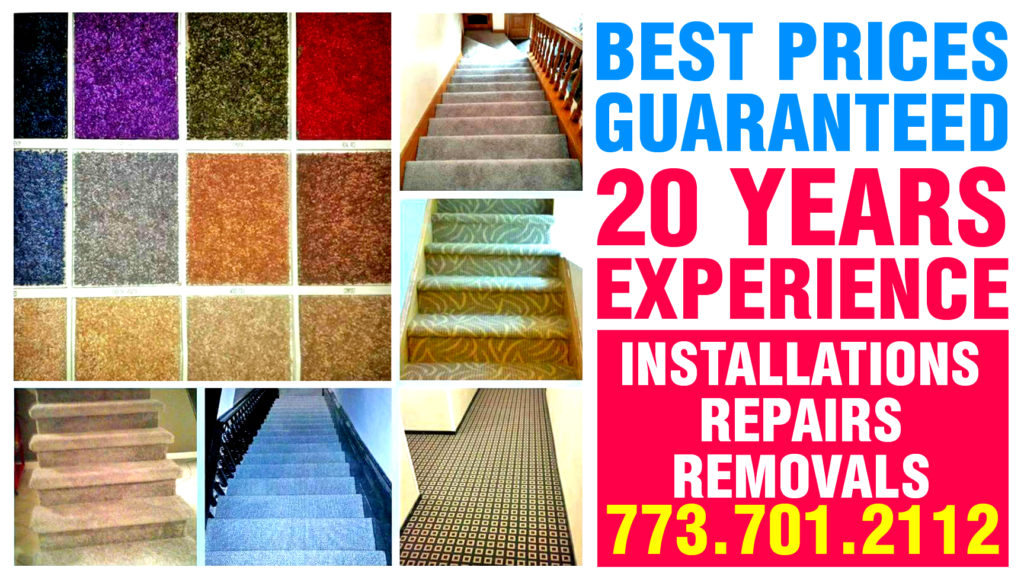Chicago Carpet Installations

Chicago Carpet Installations
Commercial – Residential – Retail


Types of Carpet
There are many different types of carpet, each with its own unique characteristics. Here are some of the most common types:
Fiber Types
- Nylon: Durable, stain-resistant, and versatile. It’s a popular choice for high-traffic areas.
- Polyester: Soft, comfortable, and affordable. It’s often used in bedrooms and family rooms.
- Olefin: Stain-resistant, fade-resistant, and easy to clean. It’s a good option for areas with pets or children.
- Wool: Luxurious, durable, and naturally stain-resistant. It’s a high-end choice for formal spaces.
- Triexta: A newer fiber that is soft, stain-resistant, and durable. It’s a good alternative to nylon.
Construction Types
- Cut Pile: The most common type, with fibers cut to a uniform length. It can be plush, shag, or loop.
- Loop Pile: Fibers are looped, creating a textured appearance. It can be Berber, frieze, or level loop.
- Cut-Loop Pile: A combination of cut and looped fibers, creating a multi-textured look.
- Patterned Pile: Fibers are arranged in patterns, creating a decorative effect.
Backing Types
- Jute: A natural fiber backing that is durable and breathable.
- Polypropylene: A synthetic fiber backing that is durable and moisture-resistant.
- Polyester: A synthetic fiber backing that is soft and comfortable.
Carpet Styles
- Berber: A loop pile carpet with a casual, textured look.
- Frieze: A cut pile carpet with a twisted, textured appearance.
- Shag: A cut pile carpet with long, loose fibers.
- Plush: A cut pile carpet with a soft, dense texture.
- Patterned: A carpet with a specific design or pattern.
When choosing a carpet, consider factors such as your lifestyle, budget, and desired aesthetic. A professional carpet installer can help you select the right type of carpet for your home.
Need Carpet Removal?
How to Remove Carpet: A Step-by-Step Guide
Removing carpet can be a daunting task, but with the right tools and approach, it can be done efficiently. Here’s a step-by-step guide to help you through the process:
Tools Needed:
- Utility knife
- Pliers
- Pry bar
- Gloves
- Dust mask
- Knee pad
Steps:
Prepare the Room: Clear the room of furniture and other obstacles.
Start in a Corner:
Begin at a corner of the room where the carpet meets the wall.
Cut the Carpet: Use a utility knife to cut along the edge of the carpet, separating it from the tack strip.
Pull Up the Carpet: Grab the carpet and pull it up, detaching it from the tack strip. If the carpet is stuck, use a pry bar to gently lift it.
Remove the Padding: Once the carpet is removed, pull up the padding underneath.
Remove Tack Strips: Use pliers to remove the tack strips along the edges of the room.
Clean the Subfloor: Sweep or vacuum the subfloor to remove any debris.
Dispose of Carpet and Padding: Roll up the carpet and padding and dispose of them properly.
Additional Tips:
Wear protective gear: Gloves, a dust mask, and knee pads will help protect you from dust, sharp tacks, and potential injuries.
Work in sections: If the room is large, divide it into smaller sections to make the task more manageable.
Be patient: Removing carpet can be time-consuming, so take your time and avoid rushing.
Need more visual guidance?
Check out these helpful tutorials:
Home Repair Tutor: https://homerepairtutor.com/
The Home Depot: https://www.homedepot.com/c/ah/how-to-remove-carpet/9ba683603be9fa5395fab90eb8b5a1b
By following these steps and tips, you can successfully remove carpet from your room and prepare it for new flooring.
